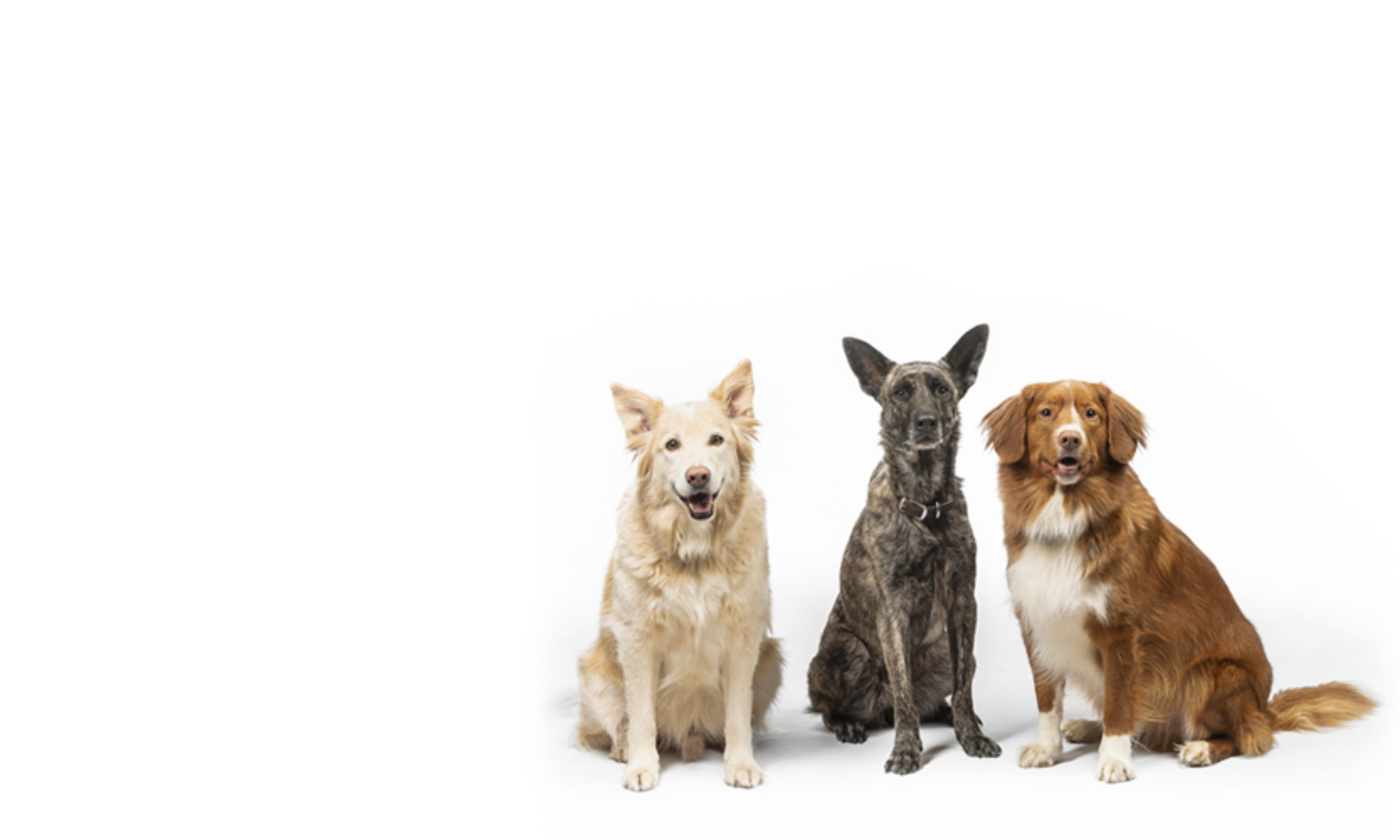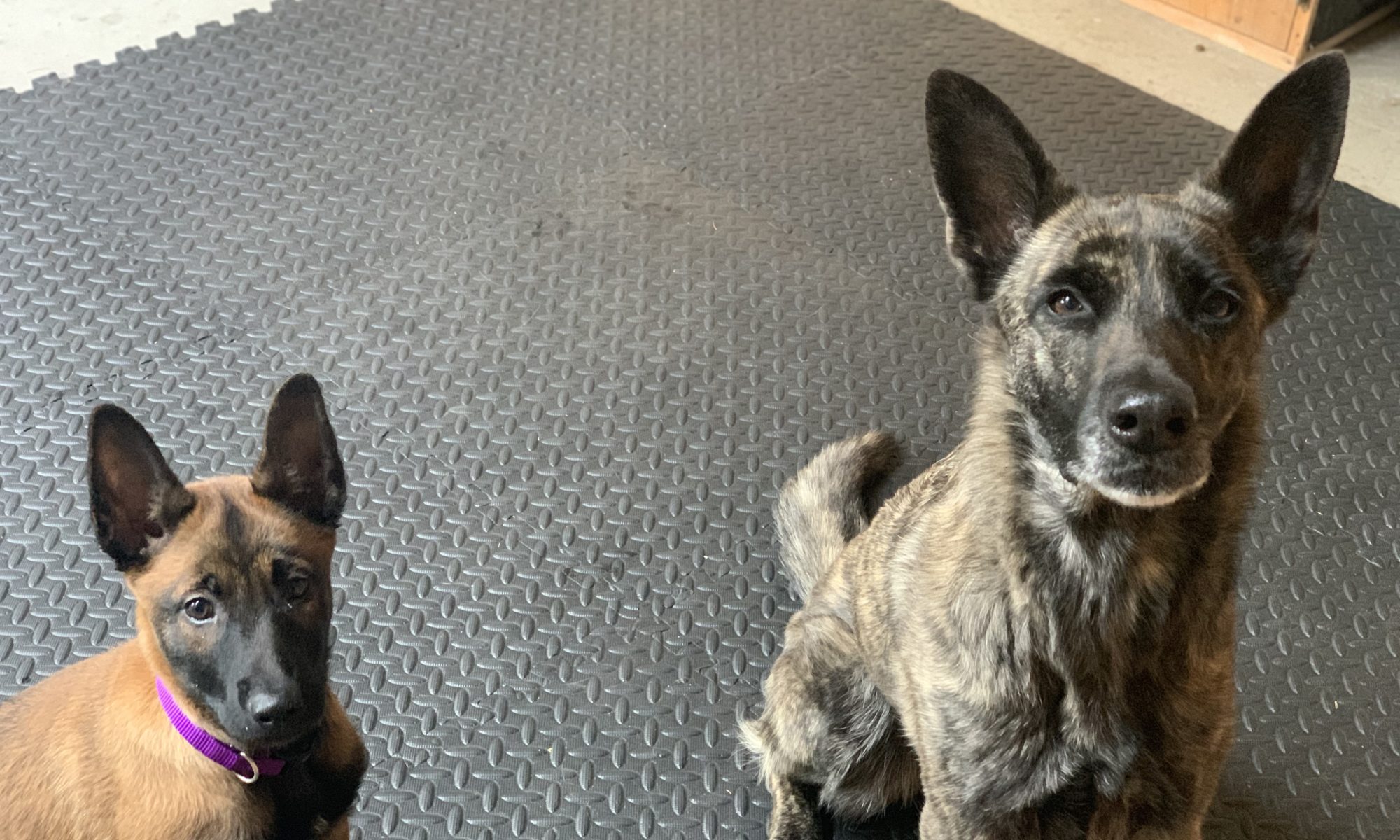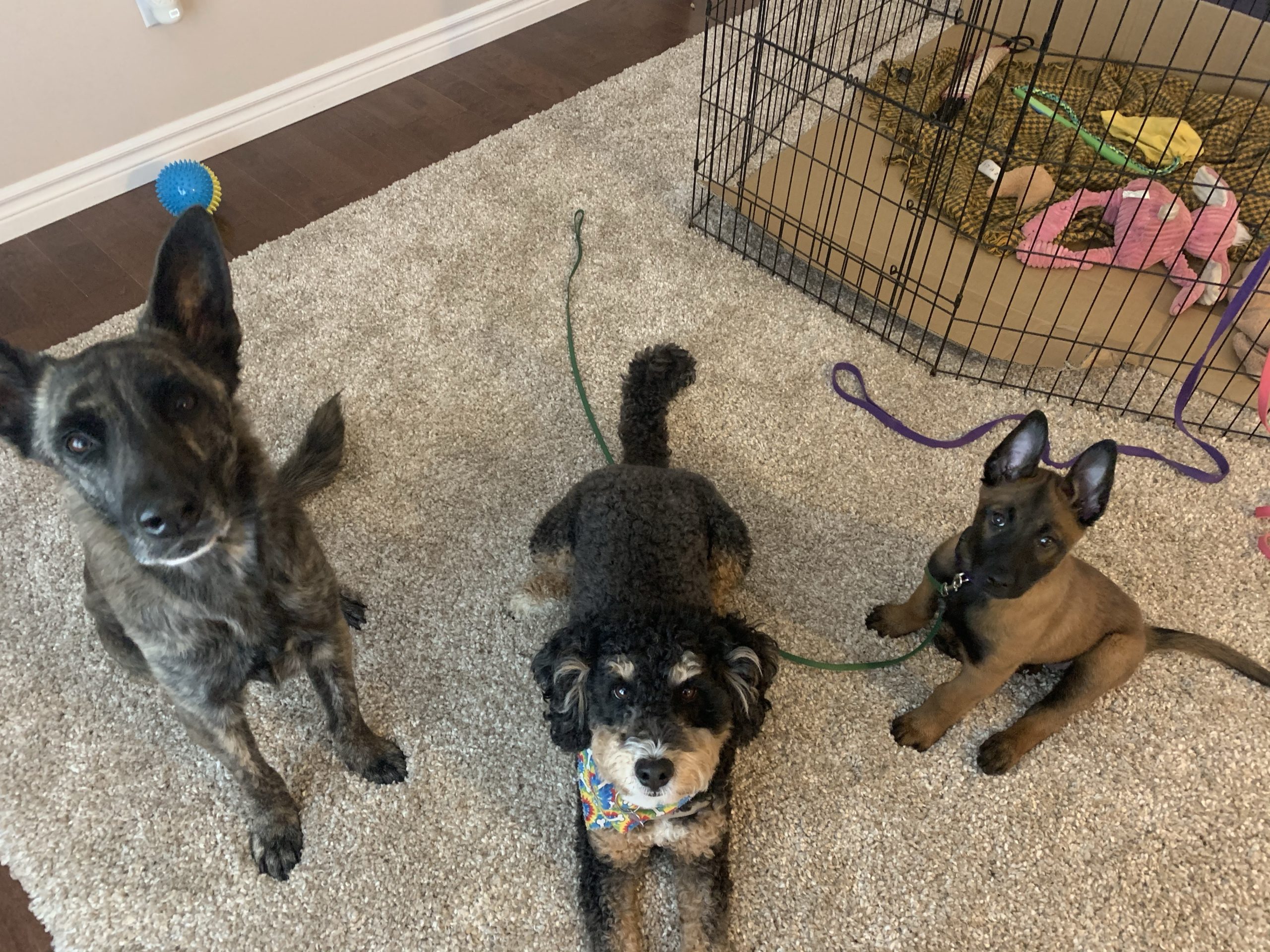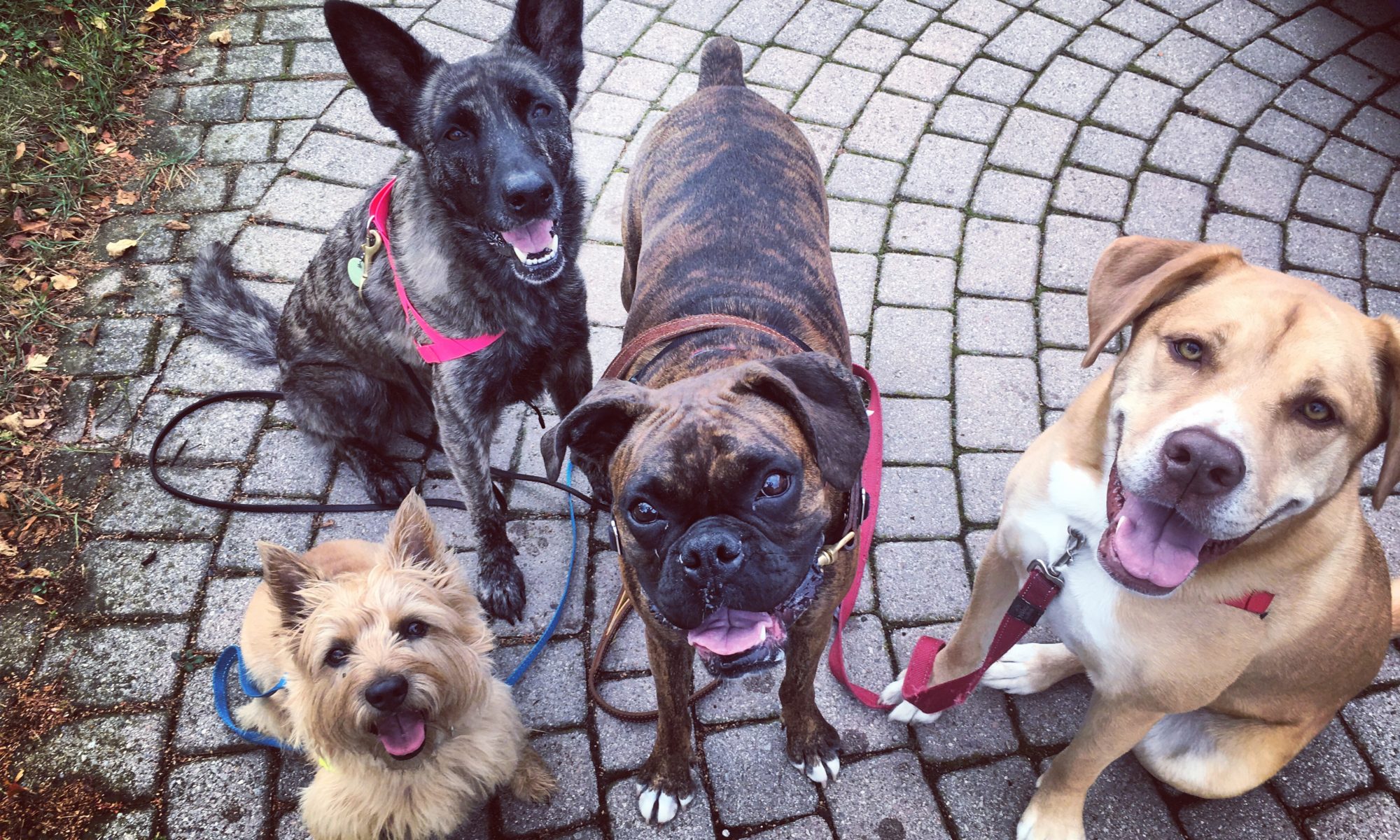Casryn’s Cowboy Bebop, 9 Weeks
It has been quite a busy week!
A week ago we welcomed our malinois puppy, Bebop into our home! Although this month has been challenging due to Ebony’s emergency surgery and recovery, we have been expecting Bebop since January and were really excited to meet her.
Bebop (her full name – Casryn’s Cowboy Bebop: named after our favourite anime show) is a Belgian Malinois. For those unfamiliar with the breed they are a high energy working dog and are typically not suited to ‘pet homes’ due to their energy and stamina. This is NOT a dog that is satisfied with two 30min walks a day or with just one round of classes on a weekend – they need to be worked daily and are rather intense in their personalities. They also like to bite. A lot (no seriously – not like a normal puppy – but like a puppy who is bred to do bite and police work). They are therefore typically placed in performance/sport or working homes only, where the dog will be stimulated, exercised and challenged in a variety of disciplines.
This is our plan and hope for Bebop! We love high energy dogs and they suit our current lifestyle.
We had been in the ‘market’ for a malinois for years as we love the breed and their energy and I wanted to find a second performance dog to train and compete with before Ebony was retired from trialing. I wanted a dog to welcome into our family that would also get along with my clients while everyone was around the same age.
I also had a specific game plan for training them from the get go which I will go into detail about in this post and in future ones!
As a general rule, I prioritize typical house manners skills but not all pet skills (such as leave it, or stay) and I go into a little detail of why that is below. I also spent a ridiculous amount of time on foundations and simple skills to make life easier later on and to create solid behaviours.
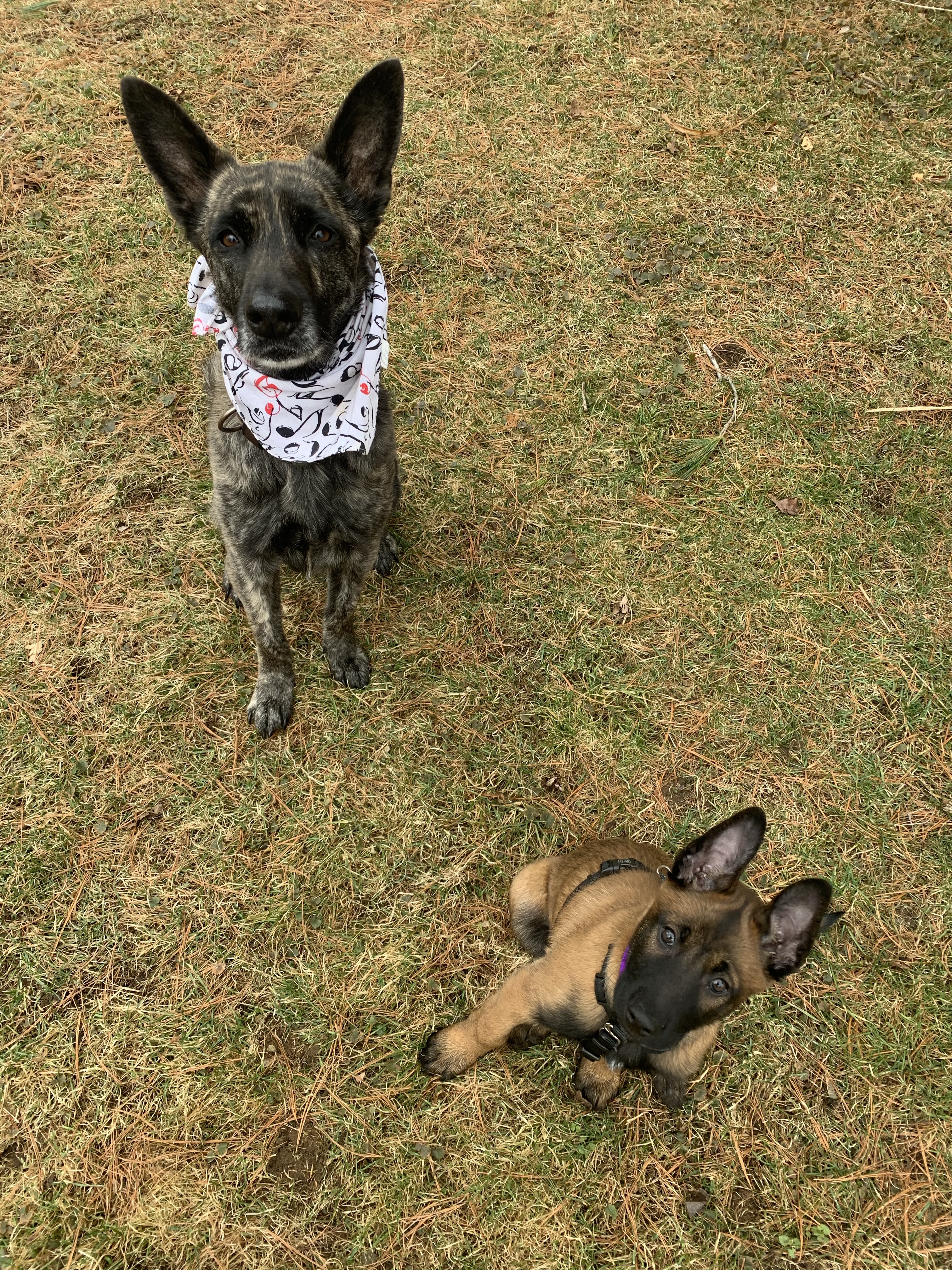
Bringing her home
Since we knew weeks ahead that we would be picking Bebop up on a Thursday, we were able to prep! As silly as it sounds I meal prepped for a couple of days and ensured her crate and expen were all set up. We also had toys and blankets ready to go. Doing this also helped my guys realize we were having company over (and they are used to it) and gave them a day to acclimate to the idea. We tried our best to prep them for no surprises.
In addition to this I prepped some chews and kongs that are age appropriate for a puppy. Bully sticks and kongs with soaked kibble (which I had picked up the week before) were prepped for her so she had something productive to do right away!
In our home, she has two expens she hangs out in with toys and chews that I rotate her being exposed to. These pens are not meant to contain her forever, but we absolutely needed a safe space for her to be a puppy while we couldn’t directly supervise her. One is upstairs, one is downstairs. In the long term, the goal is to eliminate the pens as she earns some freedom and becomes reliably crate trained.
Allowing the pens to be up gives me time to build her crate training skills appropriately in addition to teaching her to respect boundaries and gates from the get go!
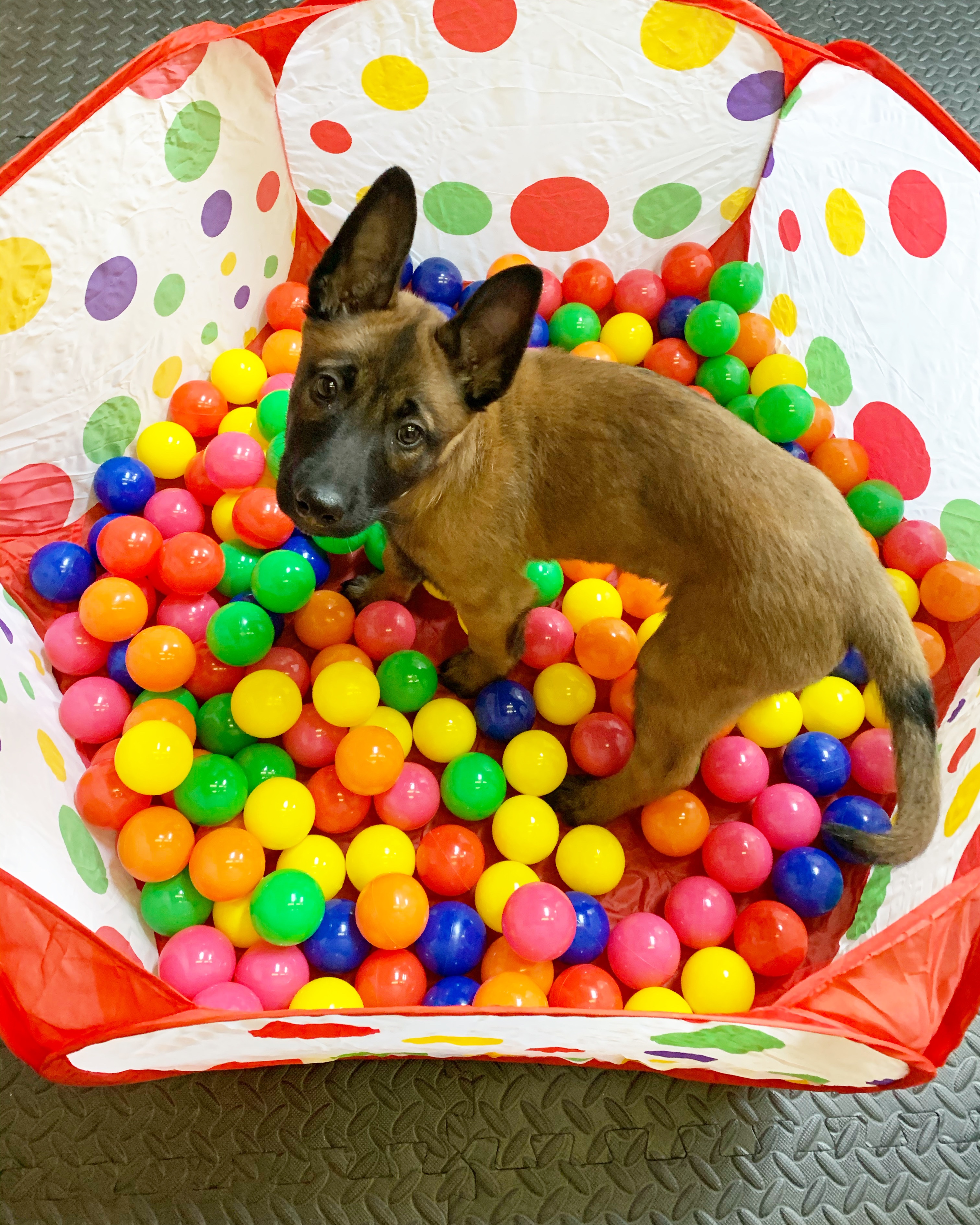
Routine
Getting puppies into solid routines is almost as important as house breaking or crate training! Dogs LOVE routines and flourish in structured schedules of training, social time, and playtime.
I also find that routines tend to empower dogs; they know what to expect and what’s coming, and for shy dogs or ones who tend to worry this can create a really positive association to your routine if they can predict it!
To see the schedule we follow see it below:
6am – wake up, pee, supervised social time/play
7am – training time, chew time, solo walk time for the dogs individually
8am – Training session, followed by chew time and nap time
8:30-10am NAP TIME
10am-2pm- Out with dogs for walks, plays and training.
2-4pm – Nap Time
4-6pm – Training session, followed by chew time and play time.
6-7 – quiet time in crate
7-9:30 – solo walk time, cuddle and quiet time
9:30 BED TIME
The other big routine factor for her? NO FREE MEALS! This puppy has not nor will she (likely) eat out of a bowl! All her kibble is measured for the day and used for training and reinforcing good behaviour. This allows us to move quickly with training goals and be a little more effective with our time.
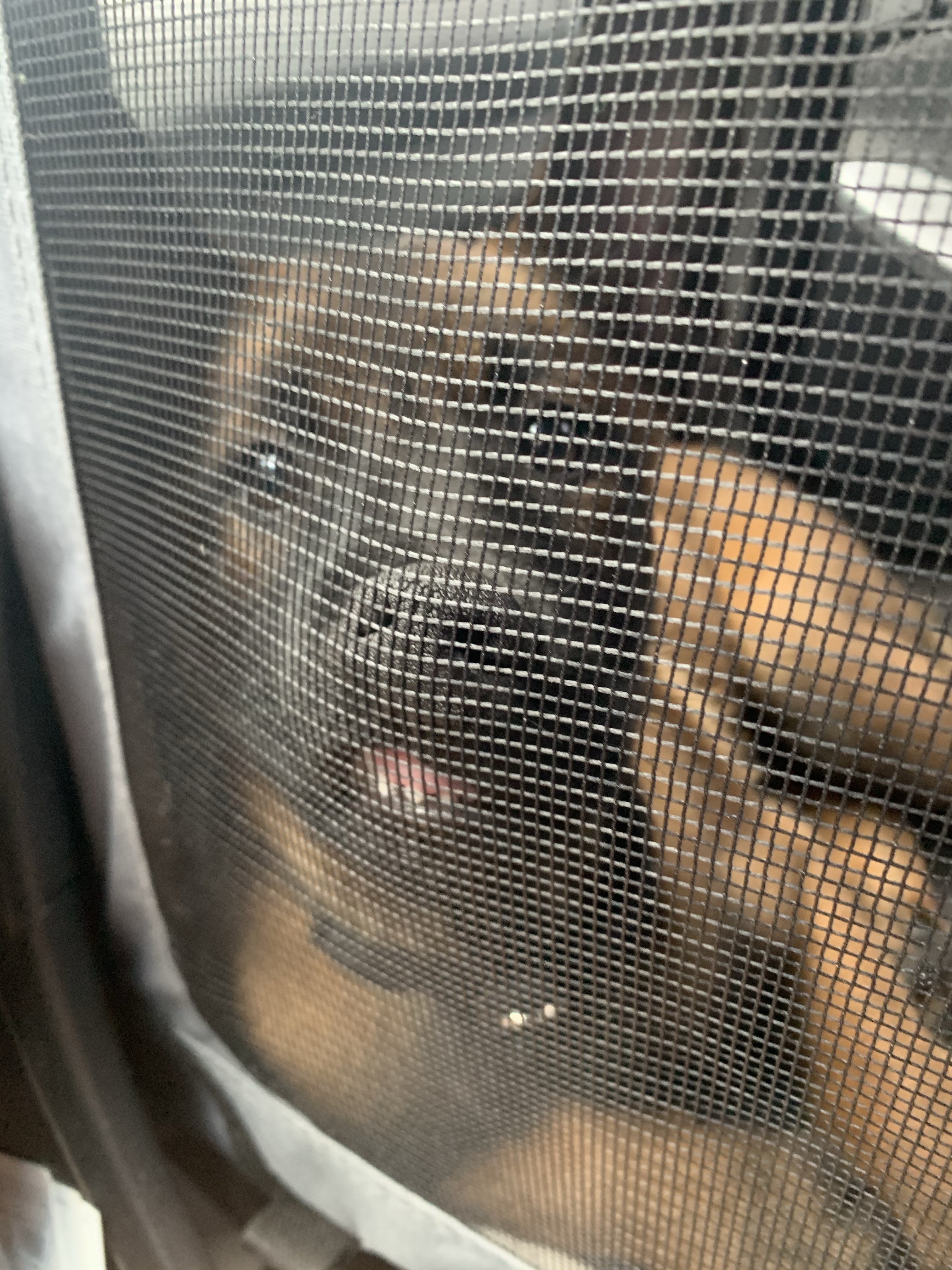
Sleep Training
We decided to be pretty particular on sleeping arrangements for this little one! We are hoping to train her in the crate room overnight but we start this process slowly. With little puppies, it can be traumatizing to leave the litter and the only home they have known and place them with humans they don’t know, in a space they have not fully explored. I liken it to sleeping in a new location with strangers – would you feel totally comfortable? Probably not!
This is why it’s so important to have some empathy towards your new puppy and patience – the crying and whining doesn’t last forever (and frankly, rarely is it like this for more than a day or two) and once they find a pattern to the bed time routine, it becomes much easier.
For sleep training, I typically start with a crate next to the bed so that I can comfort the puppy and be easily woken up if needed. Once the puppy is comfortable with that space, we start to move the crate back away from me. This process can take some time if puppy is really anxious but typically I progress it in weekly stages. The goal is to teach the puppy to be comfortable away from me (their main provider) and self soothe.
As of now, she is rocking bed time and we have pushed back the crate from my side of the bed to the far wall for the next phase of training!
Crate Training
Crate training is CRUCIAL for this dog – we have zero illusions she will be loose in the home anytime soon! She absolutely loves to put everything and anything in her mouth so for safety sake crate training is non negotiable in our home.
I start associating positive associations almost immediately in the crate. I shape movement towards it by rewarding voluntary steps in it, and then work on closing the door and leaving the dog by a few feet. Although Bebop’s meals are not fed in a bowl, she works for part of her meal by hanging out willingly and happily in her crate. I prioritize this with the crate in the bedroom, and then slowly transition it to the crate in our crate room (which we are calling her ‘big girl’ crate!)
So far, this is where the bulk of my homework is with her! She needs many repetitions of this skill so we practice it daily right now, mostly two times a day.
House Breaking
Kudos to our amazing breeder for prepping them so well – we have had ZERO accidents in the house! This girl can HOLD it in! She is let out every two hours right now, and is starting to whine in her pen if she has to go.
As a general rule with new puppies or dogs I do hourly let outs until the dog can hold it for that long consistently, then increase that duration hourly. We continue to reward potty breaks and encourage her to eliminate by cueing a verbal ‘go pee’.
Now for the fun stuff – the things I prioritize in a new dog!
Because Bebop is a performance prospect, the way I am raising her differs from your average pet.
Instead of focusing on ‘pet’ skills such as leave it, stay, and loose leash walking we are prioritizing engagement, focus and play. Although pet skills are of course important and on our list of behaviours to tackle, engagement and focus are the foundation blocks of building those skills rapidly and with eagerness from the dog. Without focus and a desire to be with me and check in with me, teaching skills become less effective and I end up with a ‘lack luster’ dog. What I want from Bebop is to show interest in me and enjoy playing with me first – in all environments – so that building the obedience pieces of skills becomes easy and most importantly FUN.
I also prioritize eye contact for EVERYTHING (that’s right – every single thing. It is time consuming at first but pays off exponentially as the dog ages) and physical handling. This is an area I didn’t invest in with Ebony and years later it showed in her reluctance to be touched or handled by vets and therapists. With this puppy, I am immediately conditioning a collar grab, a harness grab and general manipulation of her legs, feet and ears. I want a calm happy dog that is not worried about being touched for things like vet exams and grooming.
My friend who is a groomer even helped me set up a training scenario with me to get Bebop accustomed to the set up (and being up on a tall table!)
Socialization
It is a tricky time to socialize a puppy during the COVID-19 concerns but we are trying! This is probably the most important aspect right now of our training as she is at such an impressionable age.
Contrary to popular belief socialization doesn’t mean a dog has to interact with each new thing or person! What it means is exposing the dog in a controlled matter to a variety of stimuli and ensuring the dog is confident, stable and happy to be around the stimuli. With people and dogs, our goal for her is to see them, show interest but ultimately prefer having her focus on me. In a new environment, my goal is to place her in it, have her assess the space, then seek more information from me. No stress, no concerns. A bored, rather uninterested dog is what I am seeking.
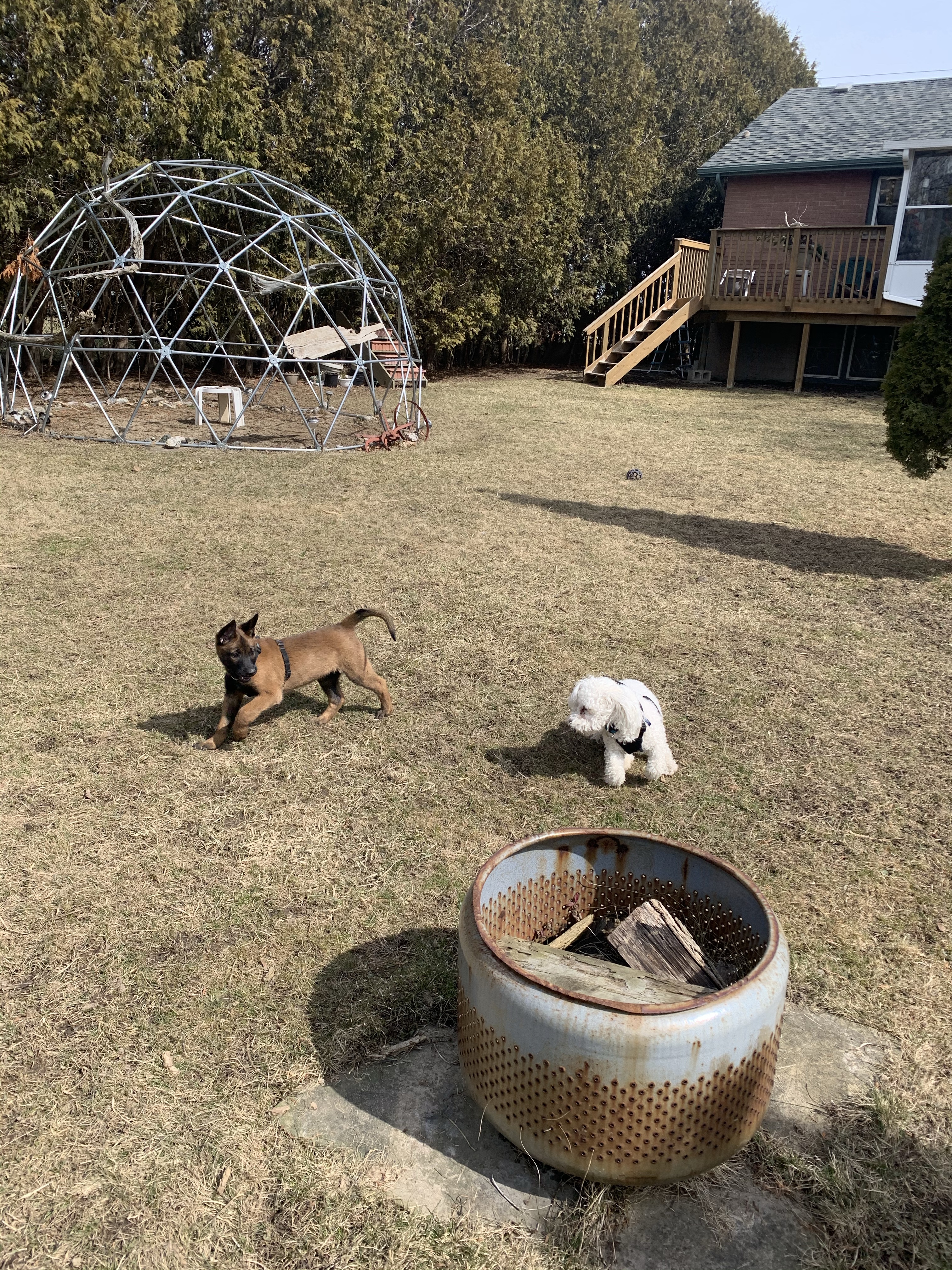
Socialization is much more than just fun interactions that can turn overwhelming quickly or reinforce poor behaviours (think of your puppy meeting new people and jumping all over them). It’s really about ensuring the puppy is stable in new environments and not fearful.
Another important factor in socializing is making sure Bebop is exposed to novel environments alone! Although her relationship with Ebony is cute to watch develop, it’s important that she learns to be OK with being solo. It is a lot of work with two dogs but it pays off long term.
What are our future goals?
For being with us just a week, she is doing great! My major goals this week include getting her to hang out in her ‘big girl crate’ longer, build upon our recall, and start some solid tug work! (in addition to position changes!)
She is a lovely, happy and goofy puppy who loves people, loves her cat Henry and looks for big sis Ebony for reassurance in new environments.
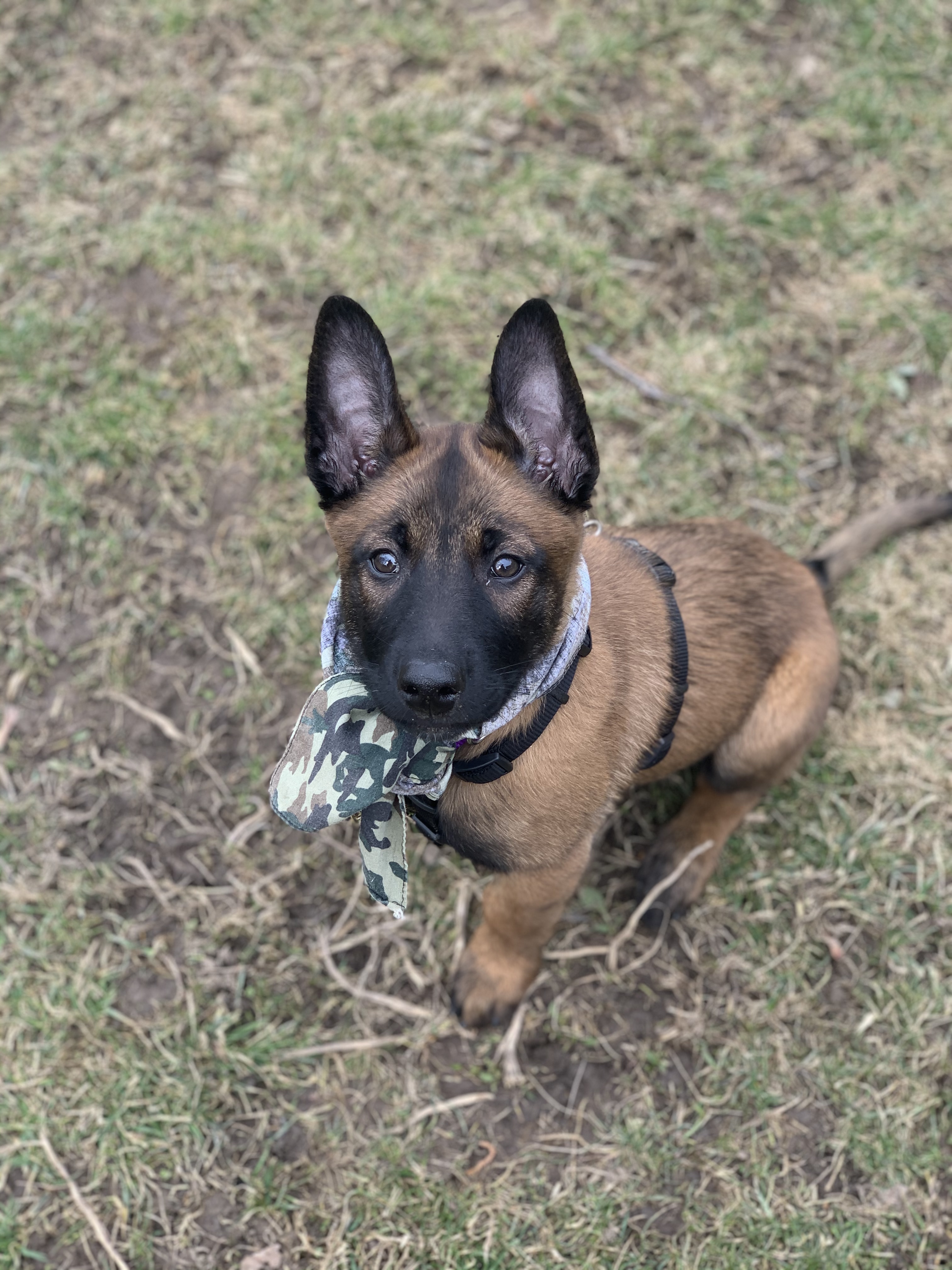
We are back! Post Move Training Thoughts…
It has been a while since my last post and I am happy to be back!
For those that don’t know – we moved! It has been both an exciting and a challenging month and as you can likely guess, a lot of training has been happening!

While the move is a blur in my memory, one aspect of the move stuck with me as I watched my guys explore settle into their new home.
The environment in which we live (or train) affects our dogs behaviour more than we may realize. Whether we are downsizing in life or getting more space, changing environments in our dogs lives will always affect their behaviour.
A good example?
When we lived in London, we lived in a condo, in one of the busiest streets in the city. It was actually right by a fire station. Noise was constantly heard – even at 2am, the sounds of cars and buses were easy to distinguish. Naturally, it became a source of comfort and the background noise to our lives.

Our animals – Henry, a cat and Ebony our dog, became desensitized to these sounds too. Not much spooked them – a door slamming, a fire truck, keys outside or barking dogs – none of it phased them. They didn’t bark or startle easily and the fact that they were raised in that type of environment is likely one of the reasons they carry such confidence in their demeanor.
Fast forward a few months, and we have relocated to a smaller, quieter town. It’s a lovely town but the quiet is bizarre. It took a week for me to sleep well through the night, and roughly the same amount of time to notice subtle little changes in our pets behaviour. They became more alert, more sensitive and a little more interested and distracted by sights they hadn’t seen before (like cows and farming equipment!)
As a trainer, I am constantly vigilant and hyper aware of changes in dog behaviour, but this observation really gave me an experience I hadn’t appreciated before. When dogs are raised in the city, they tend to adjust to city life and all of its nuances – they tend to tolerate different sounds and smells. When they live in quieter zones, they tend to not be exposed to the same experiences, therefore each new sound or distraction in city life (such as seeing dogs on leash!) can become a challenge – because it’s new!
So what did I do to help our pets adjust?
To be honest, Ebony is a well rounded dog and not much phases her but the experience had me considering instead how I would raise my second dog in a quieter area where she is likely not to be exposed to the same life experiences her ‘siblings’ were. As a result, raising our second dog is going to be a an entirely different undertaking than our first.
As a general rule, we don’t allow our dogs to bark incessantly at distractions or enjoy seeing them startle easily and prefer calm, well adjusted members of the household to frightened, unsure ones. Therefore, building a dog’s confidence through thoughtful exposure is always a priority in my life. I’ve had my work cut out for me during our move, which made me consider that perhaps many people find themselves in a similiar situation!
So here is what a well thought out training plan resembles to me in order to boost your dog’s confidence in new environments:
- First, acknowledge that our dogs may struggle with some areas of socialization and make a plan to gently expose them to it! When we lived in a busy area, our goals were to expose our dog to various scenarios and keep them calm and relaxed. We wanted them to interact safely in a busy environment. In a quieter area, our goals have shifted towards ensuring our dogs actually get exposure to city scenarios they are accustomed to or to new sights (such as cows!) – which may mean going out of our way to socialize them apropriately.
- Bring them to new locations and events, and reward appropriate behaviours – or simply reward just taking it in!
- Avoid overwhelming scenarios and sounds too early in training such as festivals or busy parks. While most dogs may seem ‘calm’ they can be easily overwhelmed with all of that stimulation and it can cause more training for you long term!
- Build your dogs confidence in the areas they are weak but recognize this should be a long term goal. Understand that it takes work, time, and a plan (and at times guidance from a reputable trainer). It is not an overnight fix and improvement is always the goal rather than perfection.

Dogs can adjust remarkably well and our pets are starting to settle into a new routine (where they occasionally see a cow, or a stray cat, big trucks or a group of dogs – sometimes all at once and it’s no big deal!) but there is always room for improvement and new scenario’s to practice in.
Uprooting environments, whether it is to a larger space or a smaller one still requires consistent management and training in order for us to get that well rounded dog we all want. The move made me appreciate that hard fact more than anything.
The training never stops here and I look forward to every moment of it!
Happy Training !
Auto-Downs and their Advantages
The most popular positions taught in basic obedience classes include a Sit and a Down. It is one of the first skills your dog probably learns when they are young! Both of these skills can be considered incompatible behaviours, and we can easily associate them with calmness. For example, if your dog is sitting at a crosswalk, they cannot pull you across the street and if they are laying down at your feet, your dog is likely nice and relaxed.

So what is an Auto down, and how is that different or better for your training?
An Auto Down is an automatic, fast behaviour. It is executed by the dog instantly after your cue, regardless of motion or distractions in the environment. It is more useful than your regular ‘down’ because it is fast and should be viewed more as an immediate ‘drop’ to the ground, rather than a slow relaxed position change to the ground.
For example, instead of the dog laying down relaxed at our feet (which is a great skill! just not the same as this one) the dog immediately ‘drop’s’ into position when cued verbally or with a hand signal, thus allowing you to manage your dog or avoid a problematic behaviour/encounter with a distraction. Need a visual? Check out the video below!
We teach this skill differently aswell. Most position changes in classes or lessons are taught primarily from a stationary position – you are either standing or sitting with your dog when teaching these skills. In an auto down, we prep the dog for movement right off the bat. We want the dog to enjoy this drill and we want to build a learning skill called drive, which is the dogs desrie to work with us and perform behaviours eagerly and accurately.
How does an Auto Down help your day to day life?
This is a skill that we have mastered from our competitive sport world, but we love it because it can easily crossover and benefit active pet owners (and makes your training fun too!).
In competition, our dogs must be able to ‘drop’ to the floor mid routine, the first time we cue it and with no immediate rewards…talk about pressure! They must also remain in this position until released or told otherwise by their handler. So if our dogs can perform it in highly distracting environments, yours can too!
If your dog is easily excitable, jumps, tends to run off or is easily stimulated during play, an automatic down can be very useful in interrupting behaviour from escalating. In addition, the fact that this skill is taught entirely with movement alows the dog to become prepared to easily perform it in comparison to stationary skills such as Sit. If you practice and your dog enjoys the skill, the chances of you succeeding in teaching them to perform goes up!
The Drill
• Lure your dog into a DOWN position, mark and reward and release your dog
• Play with them, allow them to run around and become distracted, and repeat the above steps. Release them to play/sniff/explore.
• As you practice this, and your dog improves, you will phase out a food lure and rely upon a hand signal for the position. You may even notice your dog begins to offer you this position more frequently, this is great and you want to reinforce it as much as possible.
Final Tips
Start in an easy location with your dog, and if they have trouble laying down due to age or sore joints don’t push them. You can teach this exact set up and create an ‘Auto SIT‘ instead.
Give it a shot and let us know how you like it,
Happy Training!
The Power of Playing With Your Dog
The desire to play with our dog’s is one facet of dog ownership that just comes naturally. New puppies are almost always interested in playing with their toys (and with anything that you own too!) and we take pleasure in seeing older, newly adopted or re-homed dogs ‘re-learning’ how to play.
One of the most unique aspects of dog development is that they retain their juvenile desires for social interaction and play as they age. Their love of playing doesn’t end when puppyhood is over. So it is often the case that owners want to play with their dogs but are not sure how, because play also brings about behaviours that we sometimes may not enjoy. These behaviours include growling, barking, jumping and excitability. While these behaviours can be intimidating and alarming at first, we want to encourage you to seek what style of play works for your dog, and learn the benefits it can give your training routine, as well as your relationship.

How Play Impacts Training
The benefits of play in training are often seen in dog’s who are trained for high level competition. Sports such as Obedience and Agility revolve around the dog’s ability to perform a specific set of tasks accurately, while demonstrating drive and composure. In most sports, food rewards are not allowed anywhere near the trial field – which means that dogs are performing these tasks without an immediate reward. So, how do trainers get this performance? The foundation of it revolves around play and building motivation to work together.

Most puppies exhibit curiosity and interest in novel items, it’s what makes them so much work when they are little. Exposing your dog to ‘play time’ encourages them to become independent and confident, but directly playing with them sets an amazing foundation for their life long training plan.
Playing with them, whether through tug of war, food play, or ‘chase me’ type games allows your dog to create a bond with you that revolves around direct interaction with you. If they enjoy being with you and actively seek you out, then your training foundations become easier to solidify later on when teaching, for example, focus and engagement or loose leash walking.
You also create motivation for a reward that does not always revolve around food. A toy, or direct interaction with you becomes the ultimate ‘fun’ thing to do for your puppy and eliminates the obsession that some dogs have with food rewards in training. These types of rewards are called secondary rewards (toys) and environmental rewards (access to play), and both are long term reinforces for good behaviour. This is how our dogs are able to compete and trial successfully: they find the ‘training game’ (which is really just play disguised as rewards for good behaviour) fun!
Your dog does not need to be a competition prospect to learn and benefit from these skills. You can easily implement play to perfect behaviours and teach it in a way that is controlled and safe.
How to Encourage Your Dog to Play
- Find what motivates your dog
While some dog’s prefer tug like toys, others enjoy a ball (like Ebony!). Others prefer a frisbee and some enjoy stuffed animals. Whatever toy your dog tends to gravitate towards, use it. We do not choose what motivates our dog’s – they do. It is what makes them individuals and unique, and with some careful observation about the kinds of toys they tend to pick out of their toy bin more frequently you can likely see a preference emerge!
2. Keep the toy fun and novel
We are all guilty of letting our dog’s have access to ‘too many’ toys at once; your living room may currently be littered with them! Instead, keep your dog’s favourite toy hidden and bring it out for brief periods of play with you. When play is over, the toy gets put away. You can also rotate which toys your dog has access to at once, so that every time they see an old one, it’s just like new again!
3. Start rewarding simple skills
Getting our dog’s to start working for ‘toys’ is pretty simple: just start rewarding with it! When you bring out their favourite toy, wait for them to calmly sit for you before verbally marking that correct behaviour with a YES and tossing the toy for them. This can instigate a game of fetch or tug, where you can continue to reward good behaviours. A few examples of behaviours to reward are…
- Eye contact
- Sit or Down
- An ‘OUT’ command
- Loose Leash Walking for 5 paces
- Heeling for 5 paces
- Spin
- Target
Need an example of what a controlled, calm play session looks like? Check out our video below and don’t forget to have fun with your dog. Happy Training!
Loose Leash Walking Series: Part Two
Now that we have introduced the importance of Engagement in your loose leash walking, we can start to build other behaviours!
As mentioned previously, loose leash walking is a culmination of impulse control, handler awareness, engagement, and focus. This blog post will overview training your dog to focus on you in environments you may encounter on your walks.
Focus is all about teaching your dog to look at you or ‘check in with you’. Similarly to engagement, focus is an incompatible behaviour to pulling – if your dog is focused upon you, they cannot pull you towards distractions. Most often, dogs learn to focus quickly at home and in their yards but out in the ‘real world’ they struggle. As a result, this is where a large portion of your training for this skill will be practiced. As soon as your dog is successful in the home and around it, it should be practiced outdoors and in various environments.

Focus training differs from engagement because focus is ‘cued’, which means it is eventually given a verbal command – some people may use their dogs name, or “look at me” or “watch”. Regardless of your verbal cue the behavior is set up so that you ask for it in situations that may be helpful. These include when distractions walk by you and your dog, or when they are caught looking at something for too long.
The reason we advocate for engagement to be taught before focus is because engagement training lays the groundwork for our dog’s desire to work with us. Once we have encouraged motivation and a desire to work with us, teaching Focus becomes easy!
MANAGING EXPECTATIONS ON WALKS
It isn’t a realistic expectation for our dogs to solely stare at us on a walk – that would make the excursion pretty uninteresting for them. Instead of attempting to force our dogs to stare at us and ignore distractions (which is quite frankly, difficult to do!), the goal of walks should be to balance the dog’s desires to sniff and explore while also offering us appropriate and controlled behaviours.
So how do we start?
The goal of teaching focus through the exercise outlined below is to teach the dog to glance at the things they find interesting, and wait for them to offer you a moment of focus or attention. This method of training is called Capturing – which means that we are not asking for a behavior, the dog is offering it and being subsequently rewarded for it. This reinforcement history will cause the dog to repeat this skill over and over in the future.
Think of it this way: Every time your dog pulls you towards a fire hydrant and sniffs it, they are being rewarded. Not by you, but by the consequences of their actions. Sniffing and exploring are reinforcers for our dogs just as food is, which means they will continue to practice the same patterns of negative behaviour. Spotting a distraction and pulling you excitedly towards it can quickly become a pattern in walks until we start to implement alternative behaviours. If we want our dogs to learn new skills, we need to start by setting them up for success and working on gaining their focus well before we walk them close to their distractions.
The Drill
- Have your dog on leash in a quiet, familiar environment and have treats in your pocket. Allow your dog to look, roam, and smell where they wish.
- As soon as your dog glances in your direction, mark and reward. Allow them to return to gazing or roaming.
- When they turn to you again, mark and reward.
- As your dog glances at you more frequently, reward accordingly. Try ten repetitions and see how many your dog can do quickly!
IF YOUR DOG PULLS/JUMPS TOWARDS OTHER PEOPLE/DOGS…
If you are practicing focus or engagement work with your dog and they pull or jump towards people, you are likely working too close to distractions. Try putting some distance between your dog and those distractions and try training them at that level for a period of time before making it more difficult.
It is important to note that many dogs find it challenging to walk by another dog on a busy or crowded sidewalk. Although city life has granted our dogs all the comforts of life, some dogs find on leash proximity to others dogs distressing, frustrating or too exciting. Therefore we don’t tend to recommend you allow your dog to walk too closely to another if you do not know how your dog will react, or if they are uncontrollable.

Rarely do we recommend on leash meet and greets. They can be unpredictable and hard to physically manage, not to mention any interaction your dog gains through pulling can cause them to to be reinforced by the scenario. Instead, we suggest giving your dog some distance from another pup, and working on capturing your dogs calm focus and rewarding that skill.
EXTRA TIPS
– Practice these focus drills (and your engagement exercises) outside of your normal walks and activities with your dog.
– Capture your dogs focus until your dog offers you glances continuously. A good measure of success to follow is this: out of 10 repetitions, your dog should easily do 8 (this 80% average means that your dog is understanding what you want from them the majority of the time). Once they do, you may begin to cue it through a verbal marker – “Watch” or your dog’s name are good choices.
– Do not repeat your verbal cues! Keep your training clear by ensuring you are not repeating commands. This will only confuse your dog and make your training less effective overtime. Most of this training should be silent aside from your verbal marker.

Focus is a skill that is often undervalued in dog training but it is very useful! It is even more useful when you do not have to ‘nag’ or pester your dog for the behavior. By pairing this skill with engagement training, you motivate your dog to like being with you and checking in with you through direct eye contact and through capturing. This, proofed in various environments will make your walking successful!
